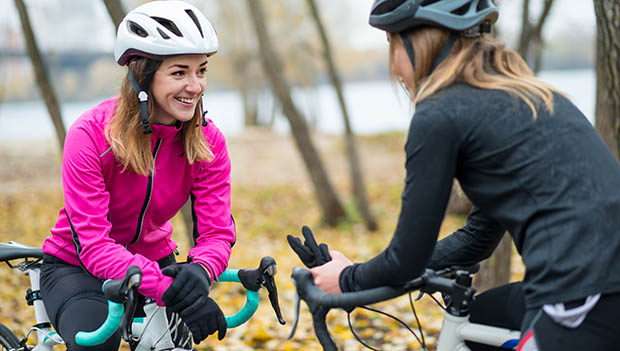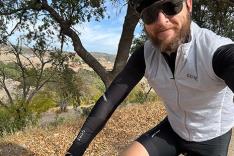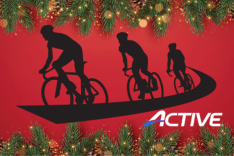
Give ACTIVE.com a search, and you'll see we've written tons of articles about all the gear you'll need to stay warm on cold rides. Many of these include cycling-specific wind and waterproof insulated jackets, thermal bib shorts and packable shoe covers (which we still highly recommend), but what if you've left the house kitted up and ready to go, but you find yourself catching a chill several miles from home?
We've gathered seven "hacks" for staying warm on these occasions, from stopping at a nearby gas station for snacks and hand warmers, to cranking up the effort as you head back home.
As a reminder, we want to emphasize safety first when it comes to riding your bike in winter conditions—roads can be icy, and conditions can often change faster than expected. Please check the weather forecasts and use your best judgement.
Snacks, Snacks, Snacks
It's always a good idea to consume enough calories during a ride to prevent the dreaded bonk, but eating consistently during a cold-weather ride does more than just give you energy—it keeps you warm, too. Eat something filling before you throw your leg over the saddle, and keep fueling the furnace every 45 minutes or so while riding with gels, chews, bars, etc. If you left home without snacks, click here for seven cyclist-friendly options you can find at most gas stations (Swedish Fish, anyone?).
Warm Beverages
Similar to staying topped off calorie-wise, reaching for warm bottles of water, tea or sports drink not only does a better job hydrating, but it will help keep you from feeling chilled every time you take a drink. You can use the same insulated bottles as you would for ice cold water on hot days, but just pour in warm (not boiling) water instead. This can be a serious morale booster on the coldest of rides.
If you don't have an insulated bottle and want to keep your liquids from freezing, move your bottles to your jersey pocket behind you. They'll be protected from the wind, and your body heat will keep the liquids slightly warmer than the outside temperature.
Reuse Snack Packaging
Remember those potato chips or gummies you ate back at your last stop? Save the bag and use it as a wind barrier for your feet. Take off your cycling shoe, slide the bag over your toes and socks, and put your shoes back on. It isn't pretty, but it's surprisingly effective at protecting your toes and feet from the elements. When things warm up, simply stop and stuff the bag in your jersey pocket to be thrown away later.
Crank up the Effort
When things get cold and uncomfortable, it's natural to want to slow the ride down and cruise your way home. We suggest the opposite—upping the intensity with short intervals throughout the ride will elevate your core temperature, both keeping you warm and helping you get home and out of the elements faster.
Newspaper
This cold-weather solution is a tried-and-true classic used by pros and amateurs alike. If you find yourself caught off guard in colder temperatures than you expected without an additional packable jacket or vest, stop at the closest gas station and pick up a newspaper. You can unzip your jersey and line the inside with some of the pages, which will help keep your core warm by both absorbing moisture and giving you a bit of insulation, as well as a wind barrier, from the temperatures. Another benefit: It's recyclable and can be disposed of once things warm up.
Hand Warmers
There's nothing more uncomfortable than freezing cold hands on a bike ride, and it seems no matter how nice your gloves are, they'll get cold after miles and miles in the saddle. For a mid-ride pick me up, pack some hand warmers in a plastic bag in your jersey pocket to pull out (our buy some at the gas station), activate and stuff in your gloves. These disposable hand warmers last hours, so when your hands have gotten enough heat, slide them down your socks or back in your jersey pocket to warm up other parts of your body.
Insulate the Noggin
You've probably heard this several times by now, but a significant amount of body heat can be lost through your head in cold weather. While a cycling cap or a skull cap will do the trick, opting for a helmet with less vents (aero helmets generally meet this criteria) also strikes a nice balance between airflow and warmth. For a hack solution, always leave a plastic disposable shower cap in your jersey pocket or saddle bag—it weighs nothing and fits over your helmet for a wind and waterproof way to keep your noggin warm. And just like reusing your snack packaging, it works as an effective foot cover, too.
READ THIS NEXT: A Quick Guide on How to Dress for Your Winter Ride








Discuss This Article